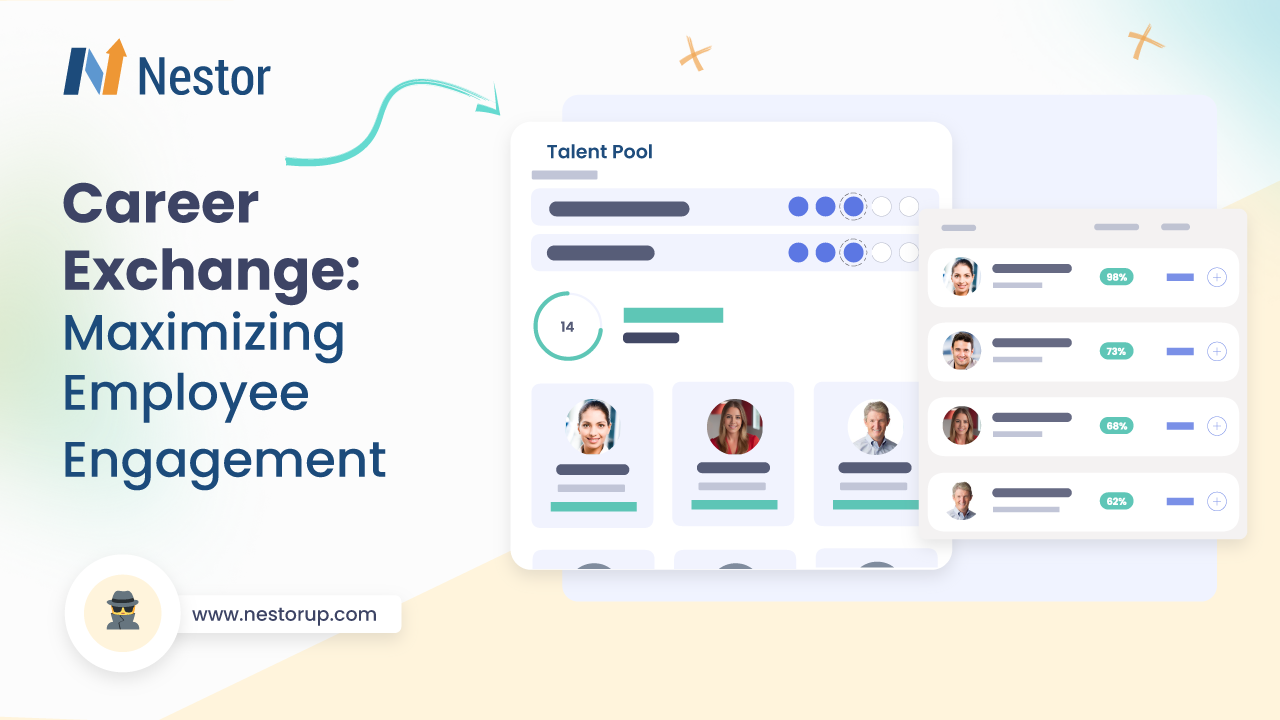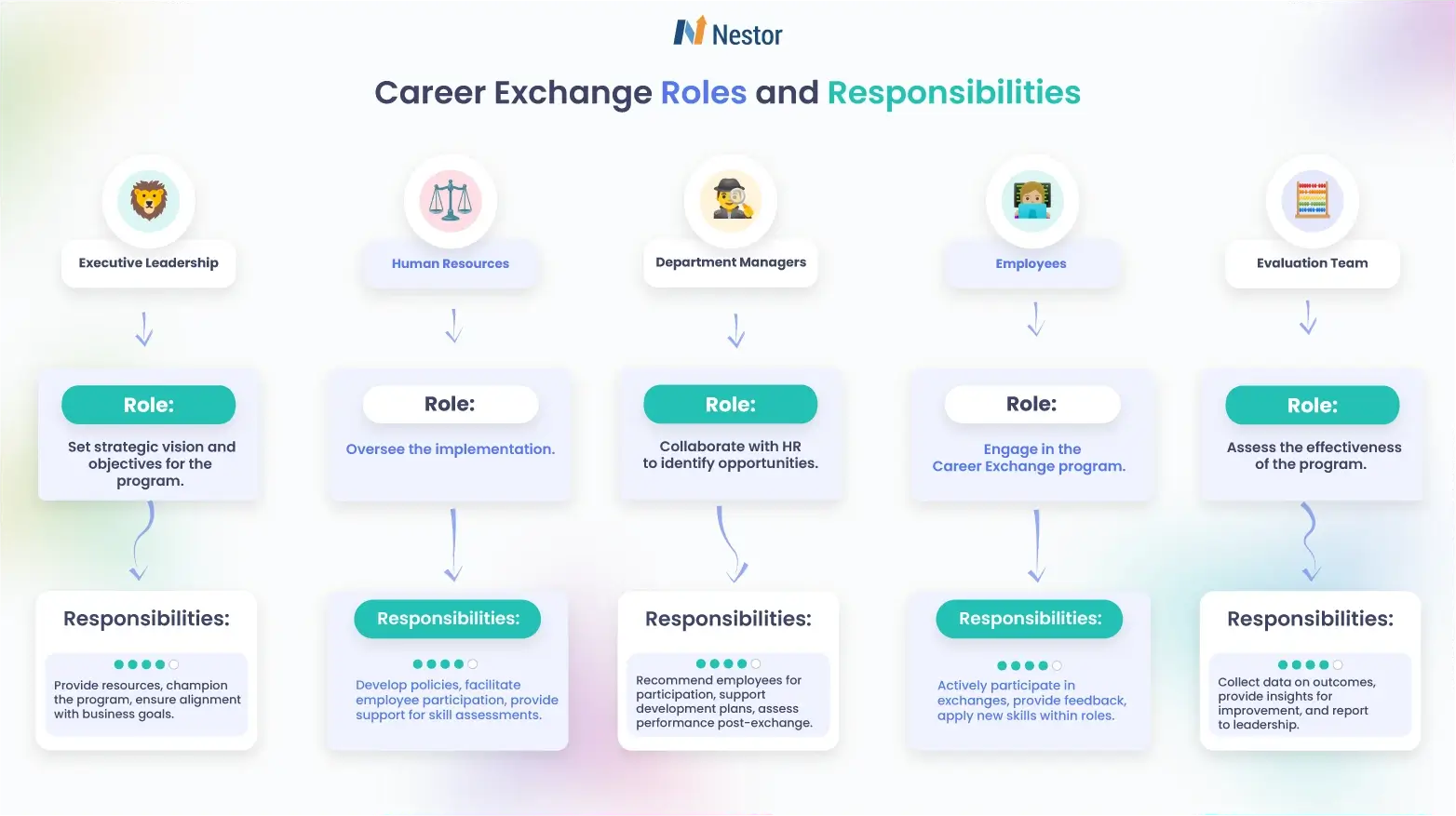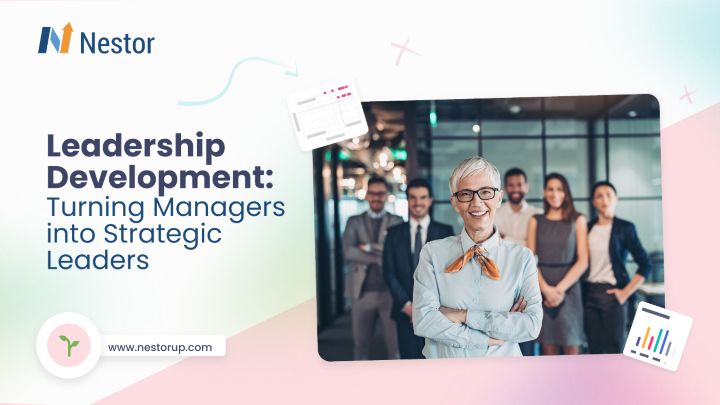
Contents
In a perfect world, employees would always be challenged, motivated, and growing within their roles. But we know that’s not how things work. Over time, even the most engaged workers can feel stuck or uninspired, often seeking greener pastures elsewhere. That’s where Career Exchange comes in.
It’s a fresh approach to career mobility within an organization that benefits everyone. How? Employees get new challenges, and companies keep their best talent. Businesses are increasingly recognizing that internal mobility isn’t just a nice-to-have but a strategic advantage.
Career exchange programs allow organizations to shift from the outdated notion of rigid career paths. Instead, they promote a more dynamic model. In this model, employees are encouraged to explore new roles and broaden their skills. Thus, organizations benefit from a more adaptable workforce.
So, how does career exchange actually work? And why should organizations consider it? Let’s dive right in!
What is a Career Exchange?
Career exchange is a structured system that encourages internal career mobility by facilitating employee movement between roles within the organization. Instead of locking employees into a single, linear career trajectory, career exchange opens up a marketplace of opportunities—whether it’s a new department, a project-based role, or even a completely different career path within the same company.
But don’t confuse career exchange with a simple job rotation program. It’s far more dynamic and strategic. The key is that employees are not limited to the traditional “climb the ladder” approach to career advancement. Instead, they can make lateral or even diagonal moves to gain new experiences and broaden their skillset.
For organizations, this means better talent retention, stronger cross-functional collaboration, and a workforce that can adapt fast. For employees, it’s a way to diversify their skills, explore new challenges, and pursue personal career growth without hitting a wall.

How Career Exchange Works
At first glance, career exchange might sound like an open invitation for employees to move around, but it’s more structured than that. Companies need to put systems in place that make it easy for employees to transition into new roles. They must also ensure that these moves benefit both the individual and the organization.
Here’s a step-by-step look at how a typical career exchange program functions:
Building a Comprehensive Skill Inventory
The foundation of any successful career exchange initiative is understanding the talent that already exists within the organization. This begins with developing skill inventories, which catalog employees’ skills, experiences, and career aspirations.
This inventory isn’t just about identifying obvious skills like “coding” or “project management.” It’s about getting a full picture of each employee’s strengths, hidden talents, and areas they want to grow.
Many businesses use a HR software to create these inventories, allowing for easy updating and matching of skills to opportunities. Others opt for a more hands-on approach, combining self-assessments with manager input and performance data.
When it comes to a HR software, Nestor is your best friend. It helps companies build comprehensive skill inventories, giving a clear view of employee skills, hidden talents, and growth areas.
With Nestor’s AI-driven skills management, businesses can map and track employee skills in real time, using a library of over 20,000 skills across 14,000 roles. It’s skill assessments combine self-assessments, peer feedback, and manager input, offering a complete picture of employee strengths.
Nestor’s skill gap analysis identifies areas needing improvement, while personalized learning paths close these gaps. The platform connects employees with internal opportunities, integrating performance management and succession planning to ensure talent development aligns with both personal and organizational goals.
In short, Nestor supports smooth career exchanges and helps companies grow talent from within.
Leveraging Digital Platforms to Streamline the Process
Once you have a clear understanding of your workforce’s skills, you need a way to connect employees to new opportunities—and that’s where technology comes in. Most modern career exchange programs rely on digital platforms to facilitate internal job postings, project-based roles, mentorship opportunities, and career development tools.
However, Deloitte reports that 49% of organizations have acknowledged they have few technological tools, if any, to identify and move people into new internal roles. Replatforming existing systems is a large part of the technological transformation program needed to address this gap.
Nestor makes this process easier. Its talent and opportunity marketplace uses AI to match employees with the right roles, projects, or gigs based on their skills. Employees can find opportunities that fit their strengths and interests.
This helps them grow and keeps them engaged. By using Nestor, companies can simplify career transitions and make the most of their talent, ensuring a smooth and efficient career exchange process.
Offering Flexible Career Mobility Options
A key feature of a successful career exchange program is flexibility. Not all employees are ready or able to make a permanent switch, which is why flexible opportunities such as short-term projects, job shadowing, or cross-departmental assignments are essential.
For example, an IT specialist may be interested in exploring the product development side of the business but not ready to make a full-time shift. They could participate in a cross-functional team for a few months, contributing to a product launch. This short-term involvement gives them valuable experience and insight into a new area without requiring them to leave their current role.
According to LinkedIn, employees at companies with high internal mobility rates remain there almost twice as long compared to organizations with lower rates. This statistic shows the importance of fostering a culture of career mobility, which leads to greater employee retention.
By offering different types of internal mobility—whether temporary assignments, lateral moves, or permanent transfers—companies allow employees to test the waters and expand their horizons without committing to a drastic career change right away. This flexibility helps employees feel empowered to take control of their career paths, while the organization benefits from having more versatile talent across the board.
The Benefits of Career Exchange for Employees, Organizations, and HR Teams
The value of career exchange extends far beyond just giving employees the chance to move around. It has wide-reaching benefits that impact every layer of the organization, from individual employees to leadership and HR. Let’s take a closer look at how it benefits everyone involved.
For Employees: Empowering Personal Career Development
- Skill Diversification and Personal Growth
Career Exchange allows employees to broaden their expertise by exploring different areas of the company. By taking on new roles, employees can diversify their skillsets and become more versatile professionals. This not only helps them in their current role but also makes them more valuable in the long term—both within the organization and in the broader job market.
Research from McKinsey found that the top reason employees cited for quitting previous jobs was a lack of career development and advancement (41%). This highlights the importance of providing opportunities for growth to retain talent and keep employees engaged.
- New Career Growth Opportunities
Traditional career paths often come with limited opportunities for advancement, especially in smaller teams or departments. According to Gartner, 86% of HR leaders believe career paths at their organizations are unclear for many employees. This lack of clarity can lead to frustration and disengagement among staff.
Career Exchange breaks down those barriers by opening up new possibilities. Employees no longer need to wait for a promotion in their current department; instead, they can actively seek out roles that align with their interests and aspirations, paving the way for quicker career progression.
- Increased Job Satisfaction and Engagement
A stagnant role can lead to boredom and dissatisfaction, which ultimately results in disengagement or high turnover. According to the latest Gallup report, only 36% of employees are engaged in the workplace, while 51% are disengaged, and 13% are actively disengaged.
Career Exchange offers a remedy by providing continuous learning and new challenges. Employees feel more engaged when they know they have the freedom to evolve within the company, leading to greater job satisfaction and loyalty.
For Organizations: Retaining Top Talent and Driving Innovation
- Stronger Talent Retention and Reduced Turnover
Career Exchange is one of the most effective strategies for retaining top talent. When employees feel like their career is progressing and that they have ample room to grow, they’re far less likely to leave for external opportunities. A LinkedIn workplace survey report found that 94% of surveyed employees responded that if a company invested in helping them learn, they would stay longer. Keeping experienced employees onboard saves recruitment costs and preserves institutional knowledge.
- Fostering Cross-Functional Collaboration and Innovation
When employees move across different departments, they bring fresh perspectives and ideas, fostering a culture of innovation. For instance, someone moving from marketing to R&D may provide a new angle on how to position a product. This cross-pollination of ideas sparks creativity, resulting in better products, services, and business strategies.
- Creating an Agile and Adaptable Workforce
For any organization, agility is key. Career Exchange helps companies build a workforce that can quickly adapt to new challenges. Employees who have experience in multiple areas of the business are better equipped to pivot when needed, whether it’s responding to a market shift or taking on new strategic initiatives.
For HR and Leadership: A Powerful Talent Management Tool
- Enhanced Talent Development and Succession Planning
Career Exchange acts as a talent development tool, helping HR identify future leaders and key players. By tracking employees’ movements and growth within the company, HR can spot high-potential individuals who could be groomed for leadership positions. This kind of internal development reduces the need to rely on external hires for critical roles and ensures a more seamless succession planning process.
- Increased Organizational Flexibility
From a leadership perspective, career exchange builds a flexible workforce that can be redeployed as needed. When employees have experience in multiple roles or departments, they can step into critical positions when unexpected gaps arise, whether due to sudden departures, organizational restructuring, or rapid business expansion.
Key Steps to Implementing a Successful Career Exchange Program

While the benefits of career exchange are clear, it requires careful planning and execution to work effectively. Here’s a step-by-step guide for companies looking to implement a career exchange program:
Develop Clear Policies and Guidelines
Before launching the program, it’s essential to establish clear policies that govern how the career exchange will work. These should cover eligibility criteria (e.g., how long employees must be in their current roles before they can apply), application procedures, and expectations for role transitions. Transparency is key—employees need to understand the process to fully engage with it.
Promote Awareness and Engagement
A career exchange program won’t succeed if employees aren’t aware of it or don’t understand its benefits. Promote the program through internal communications, town hall meetings, and one-on-one discussions between managers and their teams. Encourage employees to think about their career goals and explore the opportunities available through the program.
Leverage Technology to Streamline the Process
Invest in a platform that allows employees to explore internal job openings, manage their career profiles, and track their skill development. An easy-to-use system encourages participation and simplifies the matching process, making the program more accessible to all employees.
And if you’re wondering about “OK, but what platform should I use or where can I find something like that?”, Nestor fits this description perfectly. It offers a user-friendly interface that helps employees navigate internal job opportunities effortlessly.
With Nestor, employees can build and update their career profiles while accessing a wealth of resources for skill development. The platform’s AI-driven matching system connects employees to roles and projects that align with their skills and aspirations. By using Nestor, organizations can create an engaging environment that supports career growth and development for everyone.
Train Managers to Support Internal Mobility
Managers play an important role in supporting career exchange. Train them to recognize the value of internal mobility and encourage them to support their team members in pursuing new opportunities. This helps remove the common barrier of managers being hesitant to let go of key talent.
Overcoming Challenges in Career Exchange Programs
While career exchange offers many benefits, it’s not without challenges. Organizations may encounter resistance from both employees and managers, productivity concerns during transitions, and issues ensuring knowledge transfer. However, with careful planning and proactive solutions, these challenges can be addressed:
- Addressing Manager Resistance: Train managers to view internal mobility as a benefit, not a threat. When team members leave for other roles, it opens the door for new talent to step in.
- Maintaining Productivity: Implement transition plans that ensure smooth handovers of responsibilities and minimize disruptions.
- Balancing Individual and Organizational Needs: Ensure that moves benefit both the employee’s career development and the organization’s strategic goals. Not every move will be perfect, but it’s important to find the right balance.
Measuring Success: How to Evaluate the Impact of Career Exchange
Measuring the effectiveness of a career exchange program is vital for its long-term success. Here are some key metrics to track:
Employee Participation Rates
Track how many employees are engaging with the program, whether through lateral moves, short-term assignments, or long-term role changes. High participation rates indicate strong interest and buy-in from employees.
Retention and Engagement Metrics
Monitor retention rates of employees who participate in career exchange versus those who don’t. Higher retention among participants is a sign that the program is positively impacting job satisfaction and engagement.
Job Satisfaction and Performance Surveys
Conduct regular surveys to assess employee satisfaction with their new roles and the overall career exchange process. This feedback is invaluable for making improvements to the program.
Long-Term Career Progression
Track the career trajectories of employees who participate in career exchange to see if they achieve their goals faster or more effectively than those who stay in traditional career paths. This data helps demonstrate the long-term impact of internal mobility.
Final Thoughts
Career Exchange offers a powerful solution for employee engagement and retention. By facilitating internal mobility, organizations can create an environment where employees feel challenged and inspired. This approach moves away from rigid career paths, allowing staff to explore new roles and expand their skill sets.
Effective digital platforms like Nestor streamline this process by connecting employee skills with available opportunities. Overall, investing in career exchange strengthens talent retention, enhances collaboration, and fosters innovation.
Frequently Asked Questions (FAQs) on Career Exchange
What is Career Exchange?
Career Exchange is a program that helps employees move between roles within an organization. Moreover, it encourages them to explore new positions, departments, or projects. This approach allows for lateral and diagonal career moves instead of just climbing a single path.
How does Career Exchange benefit employees?
Career Exchange gives employees opportunities to learn new skills and take on fresh challenges. Additionally, it boosts job satisfaction by allowing them to pursue roles that match their interests. Consequently, this leads to a more engaging and fulfilling work experience.
How does Career Exchange benefit organizations?
Organizations retain top talent through Career Exchange, which reduces turnover. It also encourages innovation by promoting collaboration across departments. A versatile workforce can quickly adapt to changing business needs, enhancing overall agility.
What technology tools can assist with Career Exchange initiatives?
Tools like talent management software and AI platforms such as Nestor support Career Exchange. Specifically, these tools help build skill inventories. Furthermore, they match employees to new opportunities and streamline the internal job application process.
How can organizations measure the success of their Career Exchange program?
Organizations can measure success by tracking participation rates, retention rates, and employee satisfaction surveys. They can also assess the career progression of employees who participate to see if the program fosters growth.
Is Career Exchange suitable for all types of organizations?
Yes, Career Exchange fits various organizations, regardless of size or industry. It enhances employee engagement and skill development, making it valuable for any workplace seeking to promote growth and mobility.










